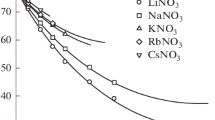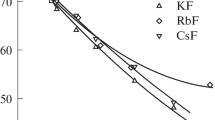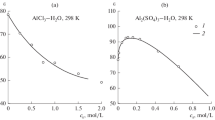Abstract
Extended Debye–Hückel (EDH) theory was used to calculate activity coefficients in aqueous solutions of alkali-metal bromides at 298 K from experimentally determined values of their static permittivities. Calculations with non-optimized model parameters fit the nonmonotonic concentration-dependent trend of the activity coefficients and the cation radius–dependent trend of the activity coefficients. The latter is explained by hydration weakening and ion association strengthening in response to increasing cation radius in the salt series.
Similar content being viewed by others
Explore related subjects
Discover the latest articles, news and stories from top researchers in related subjects.Avoid common mistakes on your manuscript.
INTRODUCTION
The extended Debye–Hückel (EDH) theory [1, 2] is a tool to calculate activity coefficients in electrolyte solutions without optimization of model parameters using experimentally determined static permittivities of the solutions. The static permittivity can be determined by dielectric spectroscopy [3, 4] via extrapolating the measured general permittivity to the zero frequency. These calculations of activity coefficients make it possible to analyze the relationship between the dielectric and thermodynamic properties of electrolyte solutions and identify the effects of solvation and ion association. Such work was carried out for solutions of alkali-metal chlorides [1], iodides [5], nitrates [6], sulfates [7], and formates [8], as well as for solutions of some sodium [9] and aluminum [10] salts. In our work, the subject matter is aqueous solutions of alkali metal bromides.
CONСENTRATION-DEPENDENT PERMITTIVITY
The dielectric properties of LiBr, KBr, and CsBr solutions at T = 298 K were studied by Barthel et al. [11]. The complex dielectric constant ε*(ω) of solutions in that work was determined in the frequency range Δν = 1.6–38.5 GHz, and the Debye fitting equation was used to determine the static permittivity via extrapolation to the zero frequency. The dielectric properties of NaBr solutions were studied by Wachter et al. [12] in the frequency range Δν = 0.2–89 GHz, and were described by a Cole–Cole process (CC model) and a three-term Debye process (3D model) with an equal success.
The permittivity values were fitted by analytical expressions (Table 1). The respective value for the permittivity of pure water was taken from [13].
Table 1 and Fig. 1 imply that, at a constant concentration, the permittivity of the solution increases as the cation radius increases, as a consequence of weakening cation hydration. The same trend is observed in the series of alkali-metal chlorides, iodides, or nitrates [1, 5, 6]. NaBr is slightly out of this trend, since the measurement and data processing procedures for its solutions [12] differ from the procedure used for LiBr, KBr, and CsBr.
ACTIVITY COEFFICIENTS MODELING. RESULTS AND DISCUSSION
The activity coefficients of water and ions in the studied solutions were calculated by the EDH equations found in previous publications [1, 2]. The EDH theory regards a logarithmic activity coefficient to be a sum of the Coulombic ion–ion interactions term and the solvation term, where both terms account for the concentration dependence of the permittivity of the solution.
The parameters of the model are a, the center-to-center distance between ions, and R±, the average ion radius, which were calculated as
where R+ and R– are the cation radius and anion radius, respectively. The Pauling ion radii system was used [14] (Table 2). The densities of solutions were borrowed from the reference book [15]. Thus, the model parameters were not optimized in the calculations of activity coefficients.
Figure 2 illustrates the results of calculation of γ±, ion-average activity coefficients at 298 K against experimental data [16]. In general, the calculated values of activity coefficients qualitatively fit their nonmonotonic concentration dependence. The model adequately predicts the order of activity coefficients for salts of different cations at a constant concentration, namely that the ion-average activity coefficient decreases as the cation radius increases. A satisfactory match with experiment is observed for LiBr solutions up to a molality of 6 mol/kg (Fig. 3). For NaBr, KBr, and CsBr, a match is observed only at low concentrations; the discrepancy increases as the cation radius increases. The primary factor responsible for this behavior of activity coefficients, similar to that in solutions of alkali-metal chlorides [1], iodides [5], and nitrates [6], is weakening of cation solvation in response to increasing cation radius. The second factor acting in the same direction is that ion association increases in the series from LiBr to CsBr in accordance with the Collins rule [17], as the difference between the radii and energies of hydration of the cation and anion decreases in this series.
Ion-average activity coefficients of aqueous alkali bromide solutions at 298 K calculated in terms of the EDH theory (left-hand panel) and experimentally determined values [16] (right-hand panel); ms is the salt molality.
(a) Water activity coefficient and (b) ion-average activity coefficient in aqueous lithium bromide solutions at 298 K. Lines show EDH fits, and circles are experimental datapoints [16]; ms is the salt molality.
CONCLUSIONS
The activity coefficients of water and ions in alkali bromide solutions calculated in terms of the extended Debye–Hückel theory qualitatively fit their nonmonotonic trends; for lithium bromide solutions, there is a quantitative coincidence up to a concentration of 6 mol/kg. The trend of activity coefficients in the salt series is due to both hydration weakening and ion association strengthening in response to increasing cation radius. The discovered relationships may be useful for predicting the thermodynamic properties of electrolyte solutions based on the characteristics of individual constituent ions.
REFERENCES
I. Yu. Shilov and A. K. Lyashchenko, J. Phys. Chem. B 119, 10087 (2015). https://doi.org/10.1021/acs.jpcb.5b04555
I. Yu. Shilov and A. K. Lyashchenko, AIChE J. 68, e17515 (2022). https://doi.org/10.1002/aic.17515
R. Buchner and G. Hefter, Phys. Chem. Chem. Phys. 11, 8984 (2009). https://doi.org/10.1039/B906555P
A. Lyashchenko and A. Lileev, J. Chem. Eng. Data 55, 2008 (2010). https://doi.org/10.1021/je900961m
I. Yu. Shilov and A. K. Lyashchenko, J. Mol. Liq. 240, 172 (2017). https://doi.org/10.1016/j.molliq.2017.05.010
I. Yu. Shilov and A. K. Lyashchenko, Russ. J. Inorg. Chem. 66, 1036 (2021). https://doi.org/10.1134/S0036023621070123
I. Yu. Shilov and A. K. Lyashchenko, Russ. J. Inorg. Chem. 65, 1240 (2020). https://doi.org/10.1134/S003602362008015X
I. Yu. Shilov and A. K. Lyashchenko, Russ. J. Phys. Chem. A 96, 2395 (2022). https://doi.org/10.1134/S0036024422100296
I. Yu. Shilov and A. K. Lyashchenko, J. Solution Chem. 48, 234 (2019). https://doi.org/10.1007/s10953-019-00860-8
I. Yu. Shilov and A. K. Lyashchenko, Russ. J. Inorg. Chem. 64, 1186 (2019). https://doi.org/10.1134/S0036023619090213
J. Barthel, J. Kruger, and E. Schollmeyer, Z. Phys. Chem. 104, 59 (1977). https://doi.org/10.1524/zpch.1977.104.1-3.059
W. Wachter, W. Kunz, R. Buchner, and G. Hefter, J. Phys. Chem. A 109, 8675 (2005). https://doi.org/10.1021/jp053299m
U. Kaatze, J. Chem. Eng. Data 34, 371 (1989). https://doi.org/10.1021/je00058a001
L. Pauling, J. Am. Chem. Soc. 49, 765 (1927). https://doi.org/10.1021/ja01402a019
I. D. Zaytsev and G. G. Aseyev, Physicochemical Properties of Binary and Multicomponent Solutions of Inorganic Compounds. Reference Book (Khimiya, Moscow, 1988) [in Russian].
W. J. Hamer and Y.-C. Wu, J. Phys. Chem. Ref. Data 1, 1047 (1972). https://doi.org/10.1063/1.3253108
K. D. Collins, Methods 34, 300 (2004). https://doi.org/10.1016/j.ymeth.2004.03.021
Funding
This work was fulfilled as part of the Governmental Assignment No. 121031300090-2 and as part of the Governmental Assignment in basic research to the Kurnakov Institute of General and Inorganic Chemistry, Russian Academy of Sciences.
Author information
Authors and Affiliations
Corresponding author
Ethics declarations
The authors declare that they have no conflicts of interest.
Additional information
Translated by O. Fedorova
Rights and permissions
About this article
Cite this article
Shilov, I.Y., Lyashchenko, A.K. Analysis of Activity Coefficients in Aqueous Solutions of Alkali Metal Bromides Based on Dielectric Properties. Russ. J. Inorg. Chem. 68, 898–901 (2023). https://doi.org/10.1134/S0036023623600685
Received:
Revised:
Accepted:
Published:
Issue Date:
DOI: https://doi.org/10.1134/S0036023623600685







